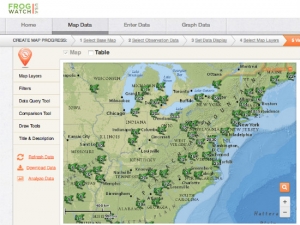 Image: A screenshot of the Frog Watch map.
Image: A screenshot of the Frog Watch map.
greenbiz.com - July 8th, 2014 - Yale Environment 360
By making the recording and sharing of environmental data easier than ever, web-based technology has fostered the rapid growth of so-called citizen scientists — volunteers who collaborate with scientists to collect and interpret data. Numerous Internet-based projects now make use of citizen scientists to monitor environmental health and to track sensitive plant and wildlife populations. From counting butterflies, frogs, and bats across the globe, to piloting personal drones capable of high-definition infrared imaging, citizen scientists are playing a crucial role in collecting data that will help researchers understand the environment. Here is a sampling of some of these projects.
(VIEW COMPLETE ARTICLE)
Problem, Solution, SitRep, or ?:
Recent Comments